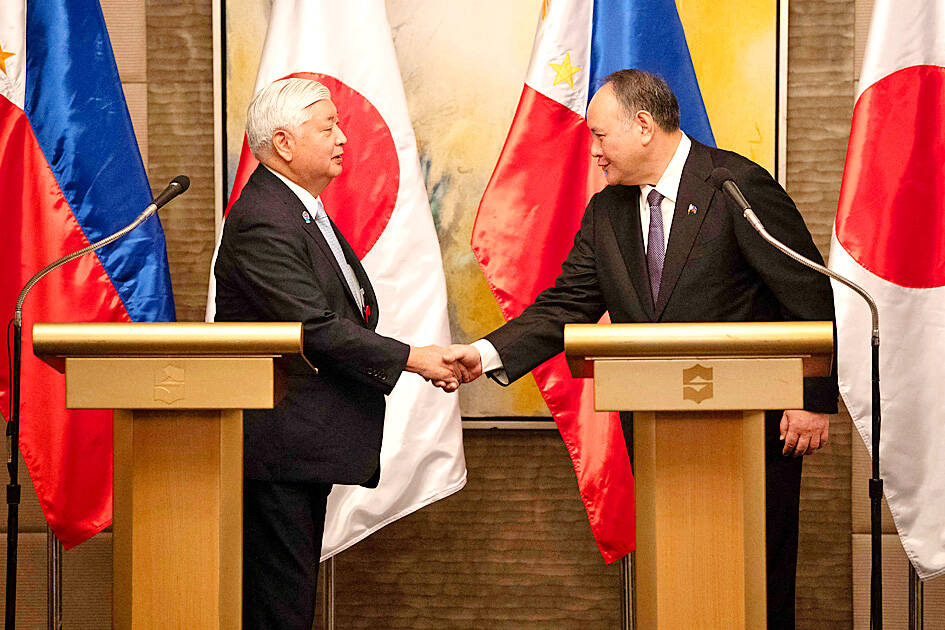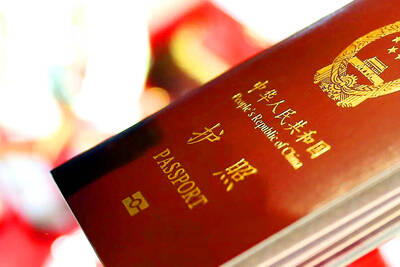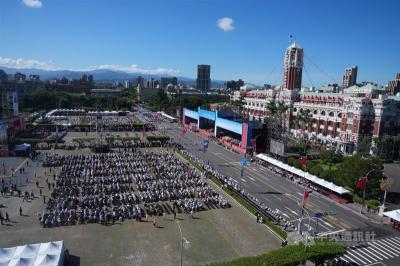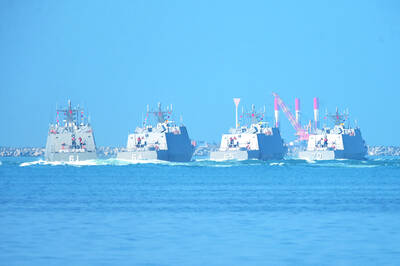An “increasingly severe” security environment has made deepening security ties with the Philippines a necessity, the Japanese defense minister said yesterday after a meeting with his counterpart in Manila.
Speaking as he concluded a two-day visit that included a tour of Philippine air bases, Japanese Minister of Defense Gen Nakatani said the two nations hoped to achieve greater operational collaboration.
“[Philippine] Secretary [of National Defense Gilberto] Teodoro Jr and I firmly concurred that the security environment surrounding us is becoming increasingly severe and it is ... necessary to further enhance defense cooperation,” Nakatani said.

Photo: AFP
He said that the nations had agreed to establish “strategic dialogue between high-level operational officers.”
Nakatani’s visit comes on the heels of a foreign ministers’ meeting last month where the Philippines and Japan vowed to strengthen security cooperation to counter China’s actions in key sea trade routes, including the disputed South China Sea.
Teodoro told yesterday’s joint news conference that the two nations shared the “common cause of resisting any unilateral attempt to reshape ... international law by force.”
China has deployed navy and coast guard vessels in a bid to bar the Philippines from strategically important reefs and islands in the South China Sea, leading to a string of confrontations.
The Philippines in December last year said that a China Coast Guard vessel used water cannon and “sideswiped” a government fisheries department vessel, and last week the Philippine Coast Guard said a Chinese navy helicopter came “within 10 feet” (3m) of a surveillance plane carrying journalists over the contested Scarborough Shoal (Huangyan Island, 黃岩島).
Japan is a key financier of Philippine efforts to modernize its South China Sea patrol craft, as well as maritime surveillance systems including radar installations.
Beijing claims the strategic waterway in almost its entirety despite an international tribunal ruling that its claim lacked any legal basis.
Both Tokyo and Manila are allies of the US, which has been strengthening an arc of alliances to deter China’s claims in the Pacific Ocean.
The Philippine Senate late last year ratified a key pact with Japan that would allow them to deploy troops on each other’s soil. The agreement, which now awaits ratification in Tokyo, also allows for increased joint combat drills.

The Ministry of the Interior (MOI) is to tighten rules for candidates running for public office, requiring them to declare that they do not hold a Chinese household registration or passport, and that they possess no other foreign citizenship. The requirement was set out in a draft amendment to the Enforcement Rules of the Public Officials Election and Recall Act (公職人員選舉罷免法 ) released by the ministry on Thursday. Under the proposal, candidates would need to make the declaration when submitting their registration forms, which would be published in the official election bulletin. The move follows the removal of several elected officials who were

The Republic of China (ROC) is celebrating its 114th Double Ten National Day today, featuring military parades and a variety of performances and speeches in front of the Presidential Office in Taipei. The Taiwan Taiko Association opened the celebrations with a 100-drummer performance, including young percussionists. As per tradition, an air force Mirage 2000 fighter jet flew over the Presidential Office as a part of the performance. The Honor Guards of the ROC and its marching band also heralded in a military parade. Students from Taichung's Shin Min High School then followed with a colorful performance using floral imagery to represent Taiwan's alternate name

FOUR DESIGNATED AREAS: Notices were issued for live-fire exercises in waters south and northwest of Penghu, northeast of Keelung and west of Kaohsiung, they said The military is planning three major annual exercises across the army, navy and air force this month, with the navy’s “Hai Chiang” (海強, “Sea Strong”) drills running from today through Thursday, the Ministry of National Defense said yesterday. The Hai Chiang exercise, which is to take place in waters surrounding Taiwan, would feature P-3C Orion maritime patrol aircraft and S-70C anti-submarine helicopters, the ministry said, adding that the drills aim to bolster the nation’s offshore defensive capabilities. China has intensified military and psychological pressure against Taiwan, repeatedly sending warplanes and vessels into areas near the nation’s air defense identification zone and across

A Chinese takeover of Taiwan would severely threaten the national security of the US, Japan, the Philippines and other nations, while global economic losses could reach US$10 trillion, National Security Council Deputy Secretary-General Lin Fei-fan (林飛帆) wrote in an article published yesterday in Foreign Affairs. “The future of Taiwan is not merely a regional concern; it is a test of whether the international order can withstand the pressure of authoritarian expansionism,” Lin wrote in the article titled “Taiwan’s Plan for Peace Through Strength — How Investments in Resilience Can Deter Beijing.” Chinese President Xi Jinping’s (習近平) intent to take Taiwan by force